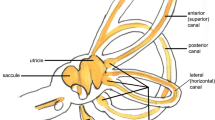Abstract
Benign paroxysmal positional vertigo (BPPV) is a common clinical disorder characterized by brief recurrent spells of vertigo often brought about by certain head position changes. General treatment for BPPV is by clinical examination by Dix–Hallpike maneuver, Video head impulse test (VHIT) is a novel test that enhances diagnostic opportunities and enables a clinician to precisely localize the site of vestibular disorders. This interested us to investigate its potential in diagnosis of BPPV.The aim of the present study is to assess the role of Video head impulse test (VHIT) in confirming the clinically diagnosed case of BPPV.All patients above the age of 18 years who were clinically diagnosed with BPPV underwent VHIT and results were correlated with clinical findings. Total 60 patients were studied in the period of 2016–2018.Among the 60 patients clinically diagnosed with BPPV, 41 were males and 19 were females. Majority of patients were in the age group of 51–60 years. Posterior canal is most commonly affected (97%) than anterior and lateral canals in BPPV. In unilateral posterior canal BPPV and bilateral posterior canal BPPV VOR (Vestibulo- ocular reflex) gains was reduced but were not statistically significant. Saccades were present only in 17 cases. There is no relationship between the presence of saccades, the canal involved and the side of the lesion.From the present study we conclude that the currently available equipment for VHIT is not useful in diagnosing BPPV. Also, strongly recommends advanced research on this to record minute changes in VOR gain.
Similar content being viewed by others
References
Bronstein AM, Lempert T, Seemungal BM (2010) Chronic dizziness: a practical approach. Pract Neurol 10(3):129–139
Halmagyi GM (2005) Diagnosis and management of vertigo. Clin Med Lond Engl 5(2):159–165
Van Esch BF, Nobel-Hoff GEAJ, Van Benthem PPG, Van Der Zaag-Loonen HJ, Bruintjes TD (2016) Determining vestibular hypofunction: start with the video-head impulse test. Eur Arch Otorhinolaryngol 273(11):3733–3739
Brandt T, Strupp M (2005) General vestibular testing. Clin Neurophysiol Off J Int Fed Clin Neurophysiol 116(2):406–426
Parnes LS, Agrawal SK, Atlas J (2003) Diagnosis and management of benign paroxysmal positional vertigo (BPPV). CMAJ Can Med Assoc J 169(7):681–693
Kattar VS, Hathiram BT (2012) Head Impulse Test. Int J Otorhinolaryngol Clin 4(2):106–11
Yacovino DA, Hain TC, Gualtieri F (2006) New therapeutic maneuver for anterior canal benign paroxysmal positional vertigo. J Neurol 256(11):1851–1855
Katsarkas A (1999) Benign paroxysmal positional vertigo (BPPV): idiopathic versus post-traumatic. Acta Otolaryngol (Stockh) 119(7):745–749
von Brevern M, Radtke A, Lezius F, Feldmann M, Ziese T, Lempert T et al (2007) Epidemiology of benign paroxysmal positional vertigo: a population-based study. J Neurol Neurosurg Psychiatry 78(7):710–715
Gupta S (2015) Prevalence of Vertigo in Different Age Groups and Common Butterfly Patterns in Electronystagmographyin Central India: A Retrospective Study. IOSR J Dent Med Sci 14(6):13–20
Harvey SA, Wood DJ, Feroah TR (1997) Relationship of the head impulsez test and head-shake nystagmus in reference to caloric testing. Am J Otol 18(2):207–213
Chung KW, Park KN, Ko MH, Jeon HK, Choi JY, Cho Y-S et al (2009) Incidence of horizontal canal benign paroxysmal positional vertigo as a function of the duration of symptoms. Otol Neurotol Off Publ Am Otol Soc Am Neurotol Soc Eur Acad Otol Neurotol 30(2):202–205
Fallahnezhad T, Adel Ghahraman M, Farahani S, Hoseinabadi R, Jalaie S (2017) Vestibulo-Ocular Reflex Abnormalities in Posterior Semicircular Canal Benign Paroxysmal Positional Vertigo: A Pilot Study. Iran J Otorhinolaryngol 29(94):269–274
Mangabeira Albernaz PL, MaiaFC, ZE (2014) The video head impulse test. Acta Otolaryngol (Stockh) 134(12):1245–1250
Author information
Authors and Affiliations
Corresponding author
Ethics declarations
Conflict of interest
The authors declare no conflict of interest.
Additional information
Publisher's Note
Springer Nature remains neutral with regard to jurisdictional claims in published maps and institutional affiliations.
Rights and permissions
About this article
Cite this article
Abdulrahim, R., Bhandary, B.S.K., Rajeshwary, A. et al. The Role of Video Head Impulse Test (Vhit) in Diagnosing Benign Paroxysmal Positional Vertigo (BPPV). Indian J Otolaryngol Head Neck Surg 74 (Suppl 1), 506–510 (2022). https://doi.org/10.1007/s12070-020-02351-5
Received:
Accepted:
Published:
Issue Date:
DOI: https://doi.org/10.1007/s12070-020-02351-5




